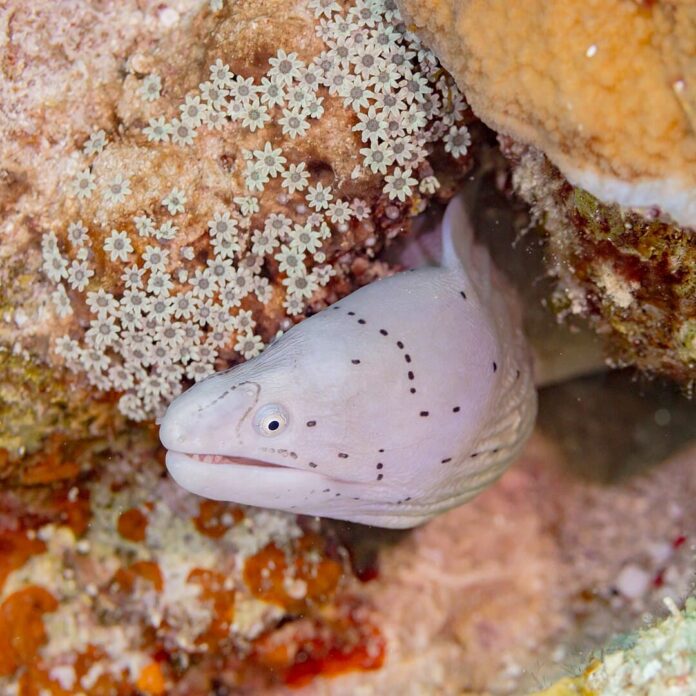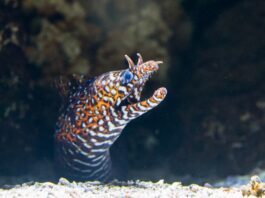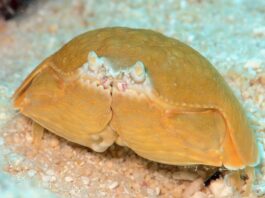When it comes to marine eel species, there are quite several to look into. Marine eels are elongated snake-like fish that live in various marine habitats from shallow to deep waters. Some of them are dangerous to be around while some are pretty okay to hang around. What these fish have in common is their poor eyesight; however, they have an excellent sense of smell for hunting. We are going to take a look at 5 interesting marine eel species below, and let me know which one is your favorite.
1Conger Eel
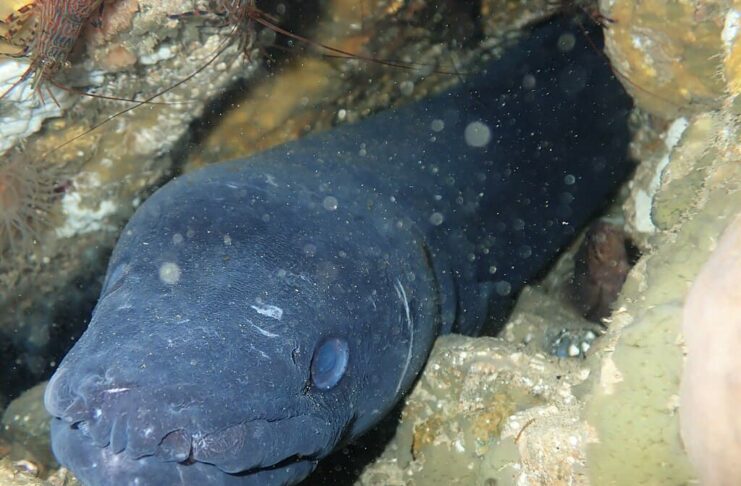
Scientific Name: Conger
Conger eel is a family of some of the largest eels in the oceans, and they look pretty interesting. Usually, this marine eel species grows up to 2 meters long but there are species that grow longer. Also, the larger ones can weigh up to over 50 kilograms which is quite heavy. A conger eel has a cylindrical body with prominent pectoral fins along with a long dorsal fin near its head. It can be black, brown, gray, or white in color, depending on the species. The main features of conger eels are the wide mouths with several rows of sturdy teeth, and they are scaleless. Being this heavy and large, it is not a surprise to know that they also attack humans; though not common. With their razor-sharp teeth, biting chunks of skin from a human is a piece of cake for them.
There are 14 conger eel species, and at least one is found in every ocean in the world. As for the habitats, these eels live on rocky and sandy bottoms in both shallow and deep water. They live in caves, reefs, and shipwrecks, and adults will move to deep water during the spawning season. Females spawn only once in their lives, and they die after. Conger eels can swim in reverse, and they are practically blind so they hunt primarily by scent. Their common food includes crustaceans, shrimps, and small fish. As bottom-feeders, they prefer to burrow in the mud when not hunting. In many countries, conger eels are important commercial and recreational species that people also consume as food fish. People harvest them using gillnets, longlines, and traps, and commercial catch is usually by large commercial vessels.
2Garden Eel
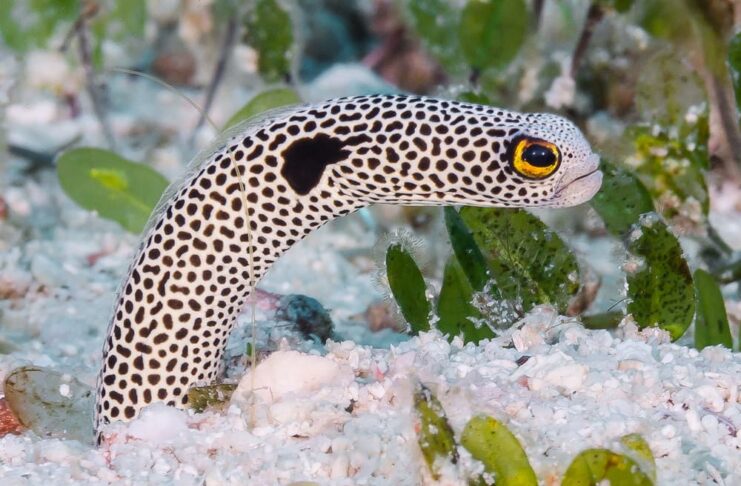
Scientific Name: Heterocongrinae
Here you are looking at the subfamily of the conger eel, and garden eels are something, aren’t they? There are 36 garden eel species in total, and they vary in color and size depending on the species. The largest of them all reach around 120 centimeters in length, but they are usually 60 centimeters long. As for the coloration, it could be black, blue, brown, gray, green, orange, white, or yellow; or a mix of a few colors. A garden eel has a slender body that looks like a grass or plant sprouting from the ocean floor. It has a pouty face and wide eyes, looking pretty adorable to some extent.
Garden eels live in the Indo-Pacific, but they also live in warm ocean water worldwide. They live in colonies in burrows on the sea floor, and there could be several thousand individuals in a surface area. These small eels poke their heads out to feed on plankton while most of their bodies are hidden on the sea floor. They spend most of their lives in burrows, and only emerge for reproduction; at night. When a male is ready to mate, he stretches toward a nearby female and ripples his tiny fins at her. If she is also ready, she will stretch to meet him. Female garden eels lay eggs after mating and leave, young garden eels do not receive care from their parents so they are independent from birth. As they grow, they also find their own colonies to join as well.
3Moray Eel

Scientific Name: Muraenidae
A moray eel generally has a patterned body and thick scaleless skin that secretes a protective mucus. This marine eel species varies in length, ranging from 15 centimeters short to 4.5 meters long. At the same time, their bright colorations are quite eye-catching, from spots and stripes to vivid patterns. It has small eyes that are not really beneficial in anything as moray eels rely on their sense of smell to hunt. Inside the moray eel’s mouth are wide jaws with large teeth that can effortlessly grasp slippery prey and tear flesh. They even have a second set of jaws that extend into their throat to help them swallow prey. These eels have a scary reputation of biting chunks of flesh off divers, and you cannot really blame them. They are not aggressive unless disturbed or frightened, and sometimes divers didn’t know they were in the eel’s territory.
There are around 200 moray eel species out there, exclusively marine but some species are seen in brackish and fresh waters. These smooth serpents inhabit temperate and tropical environments in continental shelves and slopes, deep benthic habitats, mesopelagic zones, and shallow water nearshore areas. They live in holes in the reef where they rest and wait to ambush unfortunate prey that swim by. During the day, moray eels hide in their rock crevice,s and they come out to hunt at night. All moray eels are opportunistic and carnivorous predators that feed on crabs, mollusks, octopuses, and smaller fish. Despite having so many species in the family, many moray eel species are threatened by the aquarium trade, habitat destruction, and overfishing. Hence, several moray eel species are endangered or vulnerable.
Fun Fact: Moray eels, specifically the giant moray and yellow-edged moray, are poisonous to eat.
4Snake Eel
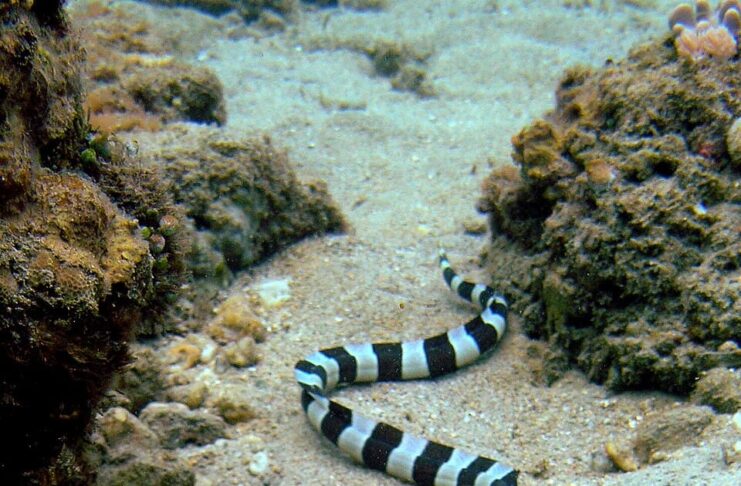
Scientific Name: Ophichthidae
Just like the name suggests, this marine eel species has a snake-like body. Depending on the species among 347, snake eels can range anywhere from 5 centimeters to 2.3 meters, or longer. Since they share the appearance with snakes, they lack fins which makes it easy for them to burrow into the substrate. These eels have spots or stripes on their body to mimic the appearance of venomous sea snakes to keep predators away. For example, a banded snake eel looks just like a sea krait, and that allows them to roam during the day.
Snake eels are found in tropical to warm temperate waters worldwide, inhabiting a wide range of habitats. They can adapt to a variety of places they call home, including coastal mudflats, mangroves, rivers, and shallow coral reefs. A majority of snake eels are bottom dwellers, and they hide in the sand by day and stalk prey by night. Not different from other marine eel species, this one also feeds on cephalopods, crustaceans, and small fish. With dull teeth and weak jaws, they cannot catch or kill prey the way the morays do. Instead, they go for slower and softer prey where they can easily catch. With poor vision, snake eels rely almost entirely on feel and smell.
5Spaghetti Eel
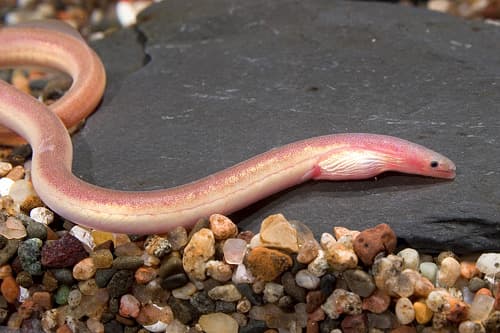
Scientific Name: Moringuidae
As for this marine eel species, it is also small and slender; hence the names spaghetti eel or worm eel. A spaghetti eel has a narrow cylindrical body ranging from 15 to 140 centimeters long. It is probably big in a picture, but it is only as thick as a pencil. But being small doesn’t mean they are friendly; they can bite if they want to. Spaghetti eels live in shallow tropical waters worldwide in the Atlantic, Indian, and Pacific Oceans, and there are 14 species of them. They inhabit sandy bottoms where there are caves and crevices for them to hide in. Once they detect prey like crabs, shrimps, and worms, they will ambush from their hiding spot.
Related Post: Dangerous Eel Species

